
|
The Sentry™
Card# MTU-017

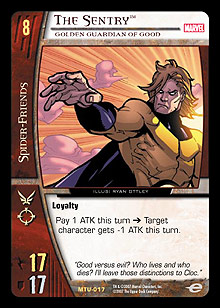
While his stats aren’t much bigger than those of the average 7-drop, Sentry’s “Pay ATK” power can drastically hinder an opponent’s attacking options in the late game.
Click here for more
|
|
|

|
|
|

 |
 |
|
|
| |
|
Last week, I gave a rough ranking of common non-character cards for draft, available here. Today I’ll do the same for characters, beginning with the two largest teams. For more general draft considerations and a better understanding of why I’m ranking the cards as I do, refer you back to a previous article.
X-Men
 1. Wolverine, Logan 1. Wolverine, Logan
While you’ll hear me emphasize the priority of taking 5 and 6 cost characters highly, Logan is very likely the premiere 3-cost character. You get some raw muscle power right at the time that it really starts to add up. He can stop any momentum that might be building up against you right in its tracks and spin it entirely around.
2. Colossus
He ranks up here for his cost of 6. His power is difficult but far from impossible to pull off in a Limited environment. You have to really try to get it to work. Your deck will need to be composed almost wholly of X-Men, and/or you will have to some ways to get characters into your KO’d pile. For example, you might want to run multiple copies of X-Men characters sharing a card name so you can power-up. Otherwise, you’ll have to get lucky and draft a Cerebro or hope that your opponent thinks Overpowered is a powerful card. At least when his power comes into action, it is often a surprise and often a game-altering one. Once you have him, be sure to try and get Marvel Team-up or the more specific team-up cards, like Heroes United.
3. Cyclops, Scott Summers
Being able to attack with impunity is quite valuable, especially when he is squaring off against a defender of cost 5 or greater. For further tips on Scott Summers, I recommend taking a look at an earlier preview.
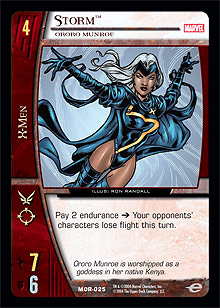 4. Storm, Ororo Munroe 4. Storm, Ororo Munroe
She matches up very poorly against other 4-cost commons such as Blob; Invisible Woman, Sue Storm; and Jean Grey, Marvel Girl without some assistance, but other than that, you are getting a lot. She is the largest common X-Men flyer, and so she is your most reliable way of getting that component into play during a game, and, via her power, you can also deny it to your opponent. Her power to remove flight lets you set up your formation much more effectively, since your protected characters really are protected from attacks by all but a very few characters, such as Spiral and Nightcrawler, Kurt Wagner.
5. Jean Grey, Marvel Girl
You’ll generally be choosing to attack rather than use her power. However, on turns you don’t have the initiative when she is likely to be attacked, her power can occasionally provide some nice treats. On turn 4, her 8 DEF sees to it that only strong 4-cost characters and team attacks can take her down. Either way, you hopefully won’t be taking too much endurance loss that turn. Also take a look at Mike Hummel’s preview, available here.
6. Professor X, Charles Xavier
Forcing your opponent to discard a couple of cards in a Limited game generally isn’t going to have a profound impact on the game. By the time he sees play, your opponent will likely have a couple of dispensable characters that wouldn’t want to risk entering the battlefield on the late turns of the game anyway. While you want to take 5-cost characters fairly aggressively, he doesn’t dramatically outshine some of the 4-cost characters.
7. Banshee
He is quite possibly the second best X-Men 3-cost character at any rarity. Since you are really looking out for Logan, though, he slips down a little ways on the chart. His flight and the ability to neutralize unsuspecting support row characters are big pluses.
8. Bishop
Of the 47 percent of the common characters in Marvel Origins that have range, two-thirds have an ATK and DEF value each less than 5. This translates into a strong likelihood that Bishop will have somebody to chase after or ward off.
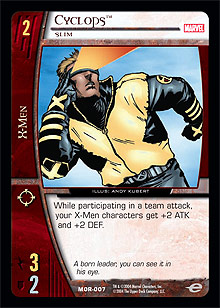 9. Cyclops, Slim 9. Cyclops, Slim
If you are drafting a focused X-Men deck, Slim may become your 2-cost character of choice. This holds especially true if you’ve accumulated a number of smaller X-Men that can come storming out of the gates. Slim can often prove useful late in the game as well, since he is part of the only pair of common namesakes and so can power-up Scott Summers. Furthermore, when your opponent plays that hard-to-deal-with character at the end of the game, Slim can give you the extra punch you need to make a team attack to take down that Goliath. You can also find further insights on Slim here.
10. Archangel
If you haven’t drafted any other flyers yet, you can take Archangel over the above two characters in good conscience. Solids stats, flight, and the ability to punish anyone who dares set foot in the support row against the X-Men make him a solid addition to most draft decks. He might not make the cut if you have enough other 2-cost characters, but he fits the slot more than adequately.
11. Dazzler
Woe is the support row character against the X-Men. If your opponent knows you have Dazzler, he or she is all the more likely to keep all of his or her characters in the front row at all times. Just the threat of Dazzler makes her scary. In order to play around Dazzler, your opponent may have to give up opportunities to reinforce or may have to leave ranged characters exposed.
12. Psylocke
If you start taking some cards out of your opponent’s hand early in the game, it will be more than a minor nuisance. How likely you are to accomplish this goal with any consistency if your opponent plays a 3-cost character of his or her own is a different story. She really pales in comparison to most of the other 3-cost characters stat-wise.
13. Shadowcat
She can make attacks for your opponent tricky and imperfect, especially in the early game. As the game progresses, the +1 DEF doesn’t amount to as much as you’d like it to, and she can become a liability on the board if she sticks around.
Brotherhood
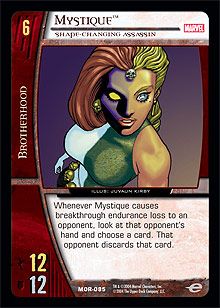 1. Mystique, Shape-Changing Assassin 1. Mystique, Shape-Changing Assassin
She earns her spot here as the best of the common 6-cost characters discussed today. In case you are wondering, yes, Dr. Doom, Victor Von Doom likely outshines her. If you have the initiative on turn 6, you should be able to take a card of your choice from your opponent’s hand. If you are in the camp that believes that 7 and sometimes 8-cost characters are often decisive to the outcome of a game, then her ability should seem more than exciting.
2. Sabretooth, Victor Creed
For limited play, I’d be hard pressed to come up with scenarios where he is more exciting than Mystique. He is a 6-drop though, and if a game takes off at a slow enough pace that you can afford to keep him on the board, he can be a real powerhouse. For more thoughts on him, see the first Vs. card preview on this site.
3. Scarlet Witch
She is significantly stat-advanced over the other common 5-cost characters. She has range and a very debilitating power. Most of your opponent’s characters suddenly start looking like they have no text. What’s not to like?
4. Blob
A 9 DEF on a 4-cost character is a serious impediment to your opponent. As if that weren’t enough, his ability to stand guard over any other Brotherhood characters is tremendous in a deck with lots of teammates.
5. Pyro
There aren’t many characters in the game that can inflict a guaranteed 3 endurance loss on your opponent every turn. When you get this ability on a character of reasonable stats, it is hard to pass up on the deal.
6. Sauron
He can be one big flyer. Send all of your other attackers in, and he can really mop up a worn battlefield. For this reason, he is less likely to encounter the stalemate scenario I described for Storm, Ororo Munroe, who shares the same stats. Like Quicksilver, Pietro Maximoff, he can really dictate the order in which your opponent must make his or her attacks. Both these characters take on the highest priority to be stunned first by your opponent.
7. Quicksilver, Pietro Maximoff
If your opponent doesn’t have much in the way of range, Pietro will cause some consternation. It will often be challenging for your opponent to stun Pietro and still have a ready character and still have made optimal attacks. Also, if you don’t have the initiative, there is a good chance your opponent won’t have anybody in the support row, and you can send a nice packet of endurance loss his or her way.
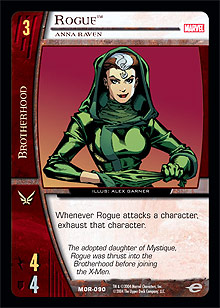 8. Rogue: Anna Raven 8. Rogue: Anna Raven
You get better stats and flight with Rogue than you do with Quicksilver. For this reason, it can often be a tossup on who is better in a deck. Her power to exhaust a defender she attacks is a nice insurance policy should her attack fail, and in times of desperation, she can hold a larger character at bay for a turn with a kamikaze attack.
9. Toad
You get a 3 ATK on a 2-drop in a team that can be very aggressive. On a turn when it figures you would be KO’ing Toad anyway during the recovery phase you can have him pop back to your hand to save you 2 endurance and maybe help you pay the cost of some future card later in the game.
10. Destiny
She stands alone amongst the 1-cost characters for the amount of endurance loss she can inflict per turn. She can’t do it alone however, and you do have to make some educated guesses as to what will take place every turn. Her extra DEF point over most other 1-cost characters can also help keep your own endurance total high. Also, check this out.
11. Phantazia
Phantazia fits into a similar type of draft deck as Destiny does, in that she can help you go after your opponent aggressively. She can make it a lot easier to keep taking down your opponents creatures, while Destiny instead rewards you more if you are able to do so without additional help. If you are lacking in other offensive tricks, Phantazia is likely to be a better fit in your deck than Destiny is. The decision comes down to how much control you need to exercise over the board as opposed to how rapidly you want to deal as much endurance loss as possible.
12. Lorelei
In contrast to the other 1-cost characters just mentioned, if your goal is to buy some time early in the game, then Lorelei does it about as well as any other 1 or 2-cost character in the set. So while she is down at the bottom of the list, she still has a role in many draft decks that just want to stay alive until the heavy hitters see play.
As always, I welcome comments at DHumpherys@metagame.com.
|
| |
| Top of Page |
|
 |
|
|
 |